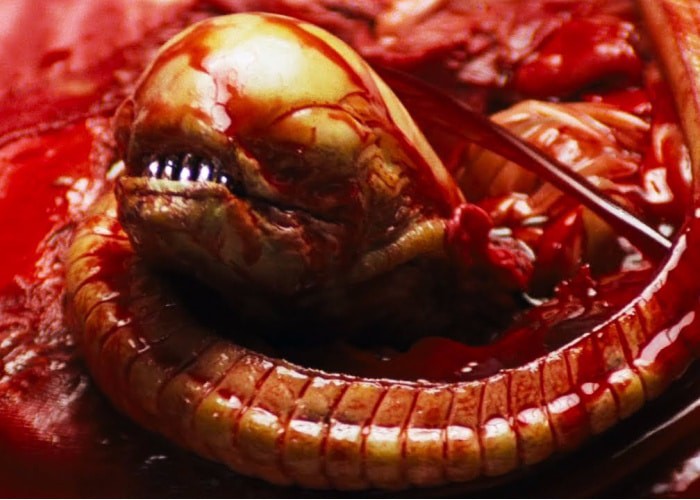A group of coworkers takes their seats around the dinner table. The day was long, and they’re ecstatic to be free from it. Smiles circle the scene; laughter ripples from one individual to the next as they exchange polite jabs at each other’s expense. Pass the noodles, gimme that orange juice. One of them recently awoke from a coma caused by a close encounter with an acid-bleeding E.T., but he came away from the experience seemingly unscathed and packing a ravenous appetite for the pathetic cafeteria grub in front of him.
Suddenly, he’s hit with a little indigestion. He coughs a quick burst of breath and expels a chunk of food from his mouth. The table pauses, “What’s the matter, man? The food ain’t that bad.” His stare intensifies. Something is seriously wrong within. The coworkers slap his back, but he’s not choking. He’s gotta stand; he’s gotta get out of there. He falls backward onto the table, and a spasm takes control of his body.
Before his peers understand his distress, his chest pops and cracks. A tiny head from inside punches out, and blood bubbles to the surface of his shirt. Then there is another butt from the stowaway beast. A geyser of red erupts blinding the coworkers to the birth. Sitting atop their friend’s sternum is a fleshy tube of teeth. The infant wails, showing off his chompers before scurrying to the darker corners of the kitchen.
Alien. Directed by Ridley Scott, written by Dan O’Bannon based on a story by O’Bannon and Ronald Shusett. Produced by Gordon Carroll, David Giler, and Walter Hill. Starring Tom Skerritt, Sigourney Weaver, Veronica Cartwright, Harry Dean Stanton, John Hurt, Ian Holm, and Yaphet Kotto. Music by Jerry Goldsmith. Cinematography by Derek Vanlint. Xenomorph design by H.R. Giger. And there are another 131 less celebrated but no less essential crewmembers listed amongst the film’s credits.
Few folks would argue that Alien is anything less than a masterpiece. Over the past forty years, movie maniacs have spent tremendous amounts of their time idolizing those creatives that contributed to this culturally adhesive film. In an era when science-fiction promised the exploration of humanity’s reach (Star Trek) or straight-up far away adventure (Star Wars), Alien yearned to stir our primordial fear of the unknown. What inspired these filmmakers to go arthouse with their B-movie scares? From where did this nightmare ooze forth? We crave the very best of behind-the-scenes material. Give us all your making-ofs and Giger Necronomicons you can publish.
Alexandre O. Phillippe takes our obsession with Weyland-Yutani’s most-prized possession one step – make that two/three steps further than anyone else has before. In his new documentary, Memory: The Origins of Alien, Phillippe constructs an excavation site around Ridley Scott’s breakout blockbuster and digs deep into its soil. He penetrates the first layer where one would uncover the thoughts of the director and the writers, worms his way beyond the second layer of obvious inspirations like H.P. Lovecraft and EC Comics, and only stops when he hits the molten lava core.
At the very start of the film, Phillippe boldly recreates a scene straight from the darkest heart of Greek mythology. We see three Furies slithering through an ancient corridor. These cursed women hiss and bear their razor-sharp teeth to the moonlight. Their rage is piercing and echoes out across the theater. It’s a promise to a quizzical audience; an impending vengeance is upon us. These are the beasts responsible for Alien.
As far as proclamations go, Phillippe delivers a mighty fearless one at the jump. The initial reaction is to cross your arms, or maybe even roll your eyes. He wins you back with the expected interviews. Diane O’Bannon, wife of Dan O’Bannon, explaining the long digestion process of the original Star Beast script, showing off scraps of notepaper with accompanying doodles. There are Tom Skerritt and Veronica Cartwright explaining the effects wizardry on set. So much rigorous context.
Resting right above the core of Alien is that magnificent magic trick – the chestburster sequence. Phillippe covers the scene from every angle. We hear from the actors who were there, the technicians pumping the tubes beneath John Hurt, as well as every possible thought that passed through each creator’s head to realize this demonic nativity. By the time Phillippe returns to the Furies, he’s taken you through an epic trip that’s included the art of Francis Bacon, the pulp of “Weird Science,” and the sexual lunacy of H.R. Giger. You’re fully prepped to comprehend his great origin reveal, and by documentary end, you’re a proud member of the Memory choir.
Alien is one of the great movies. You don’t need Phillippe to convince you of that. What Memory: The Origins of Alien reveals is how desperate we are as passionate fans for a thoughtful analysis of our favorite films. In an era where most of our conversation comes in the form of micro-Tweets, Phillippe’s cinematic essay is a great, warm hug of a movie. Here is your excuse to sit down with Ridley Scott’s most heinous and beautiful creature, and celebrate his genius as well as the mountain of other geniuses that he built upon.

